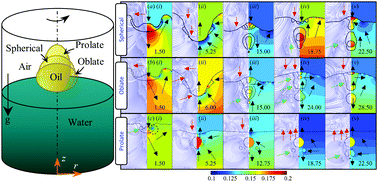Influence of the pre-impact shape of an oil droplet on the post-impact flow dynamics at air–water interface†
Abstract
We computationally explore the effects of pre-impact shape of an oil droplet on the spatiotemporal dynamics after the droplet impacts an air–water interface. Simulations reveal that the initial shape of the impacting oil-droplet alters the post-impact transient flow structures during the evolution. The spherical and oblate drop spreads over the crater to manifest interesting flow morphologies including the formation of oil-toroids and compound oil-droplets. However, the prolate drop impinges much deeper into the water pool after impact to create a few more exclusive flow features, such as, interface overturning, vortex shedding and formation of secondary droplets. The temporal variation of the crater depth shows distinct three stage dynamics, which can be explained by the generic energy analysis of the entire system. The combined theoretical and numerical energy analyses reveal the influences of the pre-impact drop shape and their effects on the subsequent energy conversion after the impact takes place. The analysis also reveals that the initial surface and kinetic energies are different for non-spherical droplets than for the spherical ones. The conversion of such excess surface energy due to the non-spherical curvature into kinetic energy dictates the impact and subsequently the crater dynamics of such systems. Such influences largely lead to the exclusive flow patterns demonstrated here. Concisely, this study presents a tri-phasic computational model, which is capable of analyzing the salient features of the impact and splash dynamics of the non-spherical droplets into a water continuum.



 Please wait while we load your content...
Please wait while we load your content...